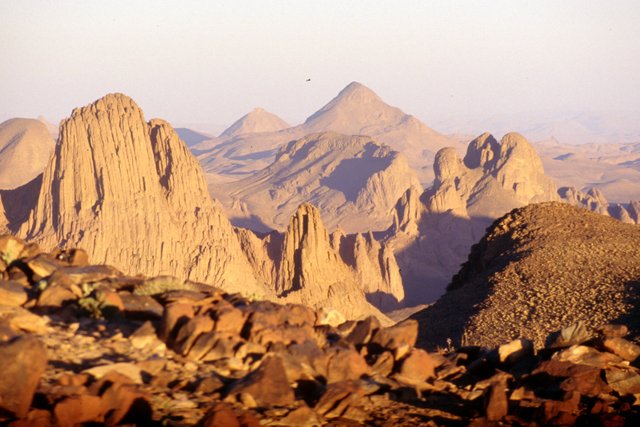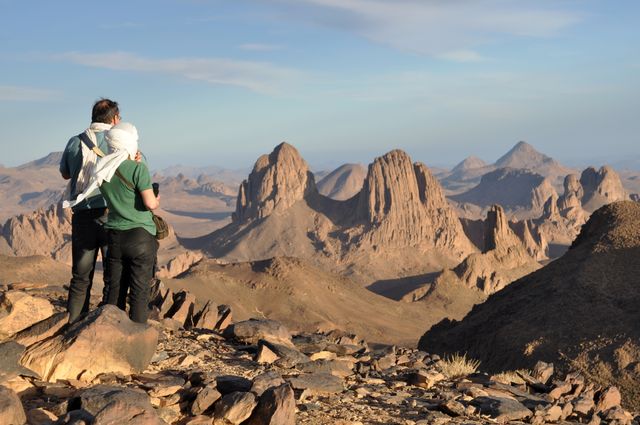Wonders of nature. Highlands Ahaggar

Landscapes, legends and people of this land, perhaps, entered the fairy tales "Thousand and One Nights."
In the Sahara, when the sun is still high, there is no horizon — only a haze of milk is visible. If you go south from the In Salah oasis to the center of the desert, then gradually through the haze you begin to notice a grandiose, seemingly endless cliff — this is the edge of the Algarian Ahaggar massif, a stunning natural phenomenon even against the backdrop of an endless number of other African wonders. Ahaggar is a huge island, about the size of France, washed on all sides by the sandy ocean of the Sahara. On three sides it is bounded by sheer cliffs, and in the west it descends gently to the plateau of Tanezruft — the Land of Thirst, in which the traveler, behind the caravan, was doomed to death.

Ahaggar, also known as Hoggar, is a granite plateau. In his heart — Atakor — lava flows covered the granite with a 200-meter layer of basalt, reminiscent of a giant pile of slag.
Fantastic towers, battlements and spiers from the phonolith rise almost 3000 meters. When these rocks cooled, they split into long prismatic formations, often compared to organ tubes. In one part of Atakor, in an area of about 800 square kilometers, more than 300 such monoliths create a landscape that strikes any imagination. The Tuareg, a nomadic people who have lived in the Ahaggar region for at least 2000 years, call this place Assecrem, the End of the World.
On the territory of the Aghagar massif there is very little vegetation, and in the mountains it is not at all. Rains fall out rarely and are usually very short, but here and there in the gorges with sheer walls, which hold up the evaporation, the water gathers into small puddles. In such places, even some plants appear, creating the illusion of coolness. No matter how few such puddles are here, their importance in the life of Tuareg can not be overestimated.
People hiding the face
The Ahaggar Tuareg are amazing people. They are high and have fair skin; Adult men cover their face with a special veil - as some say, to prevent evil spirits from entering through the mouth. They carry long swords and daggers, as well as shields made of skins of white antelope. They are considered descendants of the mysterious warriors on chariots, which are depicted in the rock drawings of the highland plateau of Tassili n’Ajjer.
Tuareg — "abandoned God" — very late adopted Islam, and until now their religion is somewhat different from traditional Islam. Women do not close their faces and have great influence in a normally monogamous family.
Until the end of the XIX century, the Ahaggar Tuaregs owned most of the desert, stretching from the Tamanrasset and Ain Salah oasis cities, where they traded ivory, gold and slaves, and also earned caravans.
Having learned in 1881 that a threat to their habitual way of life arose because of France's plans to build a trans-Saharan railway, they killed members of the expedition sent for reconnaissance of the route. The determination of the Tuaregs and their sinister appearance made a strong impression on the French, and they began to form legends about them. The most striking Pierre Benoit included in the novel "Atlantis", written in 1919. She talks about Antine, the beautiful queen of Atlantis, who lives in a castle in the Aghaggar mountains, seducing and killing young French officers. Later, in 1925, archaeologists announced the discovery of a skeleton of a woman who was buried with royal honors. In the press she was immediately christened Antineas.
The result was amazing. French officers scoured the mountains in search of further evidence, and even the great explorer Henry Lote was influenced by this legend. In 1928, when he discovered a rock drawing of a woman in a remote cave, he called her Antinea, the siren of Ahaggar.